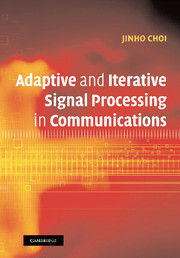Refine search
Actions for selected content:
6778 results in Communications and signal processing
Contents
-
- Book:
- Modem Theory
- Published online:
- 05 June 2012
- Print publication:
- 26 November 2009, pp vii-xi
-
- Chapter
- Export citation
Bibliography
-
- Book:
- Modem Theory
- Published online:
- 05 June 2012
- Print publication:
- 26 November 2009, pp 479-487
-
- Chapter
- Export citation
Dedication
-
- Book:
- Modem Theory
- Published online:
- 05 June 2012
- Print publication:
- 26 November 2009, pp xv-xvi
-
- Chapter
- Export citation
5 - Passband Modulation
-
- Book:
- Modem Theory
- Published online:
- 05 June 2012
- Print publication:
- 26 November 2009, pp 131-175
-
- Chapter
- Export citation
11 - Performance of Practical Demodulators
-
- Book:
- Modem Theory
- Published online:
- 05 June 2012
- Print publication:
- 26 November 2009, pp 399-452
-
- Chapter
- Export citation
2 - Baseband Modulation
-
- Book:
- Modem Theory
- Published online:
- 05 June 2012
- Print publication:
- 26 November 2009, pp 31-57
-
- Chapter
- Export citation
4 - Sequences at Baseband
-
- Book:
- Modem Theory
- Published online:
- 05 June 2012
- Print publication:
- 26 November 2009, pp 94-130
-
- Chapter
- Export citation

Adaptive and Iterative Signal Processing in Communications
-
- Published online:
- 23 November 2009
- Print publication:
- 16 November 2006
Notation
-
- Book:
- Iterative Error Correction
- Published online:
- 05 June 2012
- Print publication:
- 19 November 2009, pp xv-xviii
-
- Chapter
- Export citation
7 - Density evolution and EXIT charts
-
- Book:
- Iterative Error Correction
- Published online:
- 05 June 2012
- Print publication:
- 19 November 2009, pp 237-282
-
- Chapter
- Export citation
Commonly used abbreviations
-
- Book:
- Iterative Error Correction
- Published online:
- 05 June 2012
- Print publication:
- 19 November 2009, pp xix-xix
-
- Chapter
- Export citation
Frontmatter
-
- Book:
- Iterative Error Correction
- Published online:
- 05 June 2012
- Print publication:
- 19 November 2009, pp i-vi
-
- Chapter
- Export citation
4 - Convolutional codes
-
- Book:
- Iterative Error Correction
- Published online:
- 05 June 2012
- Print publication:
- 19 November 2009, pp 121-164
-
- Chapter
- Export citation
Contents
-
- Book:
- Iterative Error Correction
- Published online:
- 05 June 2012
- Print publication:
- 19 November 2009, pp vii-x
-
- Chapter
- Export citation
6 - Serial concatenation and RA codes
-
- Book:
- Iterative Error Correction
- Published online:
- 05 June 2012
- Print publication:
- 19 November 2009, pp 201-236
-
- Chapter
- Export citation
8 - Error floor analysis
-
- Book:
- Iterative Error Correction
- Published online:
- 05 June 2012
- Print publication:
- 19 November 2009, pp 283-321
-
- Chapter
- Export citation
Index
-
- Book:
- Iterative Error Correction
- Published online:
- 05 June 2012
- Print publication:
- 19 November 2009, pp 331-335
-
- Chapter
- Export citation
3 - Low-density parity-check codes: properties and constructions
-
- Book:
- Iterative Error Correction
- Published online:
- 05 June 2012
- Print publication:
- 19 November 2009, pp 75-120
-
- Chapter
- Export citation
1 - Channels, codes and capacity
-
- Book:
- Iterative Error Correction
- Published online:
- 05 June 2012
- Print publication:
- 19 November 2009, pp 1-33
-
- Chapter
- Export citation
References
-
- Book:
- Iterative Error Correction
- Published online:
- 05 June 2012
- Print publication:
- 19 November 2009, pp 322-330
-
- Chapter
- Export citation
